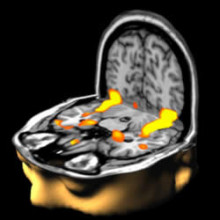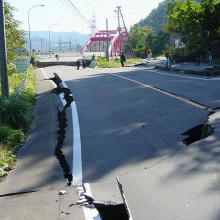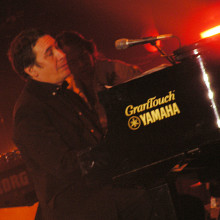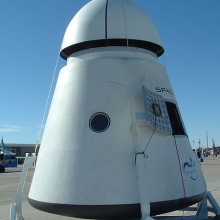On this festive NewsFlash we bring you the latest hot Science news, as well as some of the top news stories from 2008. We find out how scientists can recreate a picture as you're looking at it, just by reading your thoughts, why shape-memory metal could make bridges earthquake-proof and how a simple process could make the cheapest, nastiest wine palatable!
In this episode

Mind Reading a Reality?
Scientists in Kyoto have reproduced an image based on how the brain responds - effectively reading the brain.
 Yoichi Miyawaki and colleagues at the ATR Computational Neuroscience Laboratories have published a report in the journal Neuron, where they used functional Magnetic Resonance Imaging (fMRI) to observe the changes in brain activity when a subject is looking at an image. Using complicated computer modelling, they were able to train the system to recognise what happens in the brain in response to certain images, and the system was then able to accurately reproduce images that the subject had not seen before.
Yoichi Miyawaki and colleagues at the ATR Computational Neuroscience Laboratories have published a report in the journal Neuron, where they used functional Magnetic Resonance Imaging (fMRI) to observe the changes in brain activity when a subject is looking at an image. Using complicated computer modelling, they were able to train the system to recognise what happens in the brain in response to certain images, and the system was then able to accurately reproduce images that the subject had not seen before.
The images were simple, high contrast pictures, a 10 by 10 grid with each 'pixel' containing a shade from white to black, on which they could produce random patterns called a contrast map, geometric shapes or letters. In the training stage, they showed the subject 440 random images for 6 seconds each while observing the fMRI, which recorded brain activity by looking at blood flow in the visual cortex, which is located at the back of your brain.
Their computer model went to work by analysing small, overlapping portions of the fMRI in 3 dimensions, and then putting together the data from each portion to reconstruct how the brain responded to each image. Using multiple portions allowed them to build up an idea of the brain's response, with the overlaps reducing the error, as each section was sampled more than once. Once it was trained on the random contrast maps, they moved on to showing the subject more defined images, such as letters and geometric shapes.
From the fMRI data, the computer model was able to reconstruct the images as seen by the subject, such as spelling out the word Neuron. It's only able to work in black and white at them moment, and relies on the images having quite high contrast, but the team think that improving measurement accuracy should enable it to work in colour, and one day may be able to produce images from dreams, or even a direct readout of someone's feelings.
This is a good start, but they have a long way to go before you can upload your dreams at night to watch later on!

How to give your cheap plonk a boost
The festive season is upon us, many of us will no doubt be raising a glass or two of wine in celebration. And this week there is news of a novel way that scientists have found to give a boost to a bottle of cheap plonk. A revolting young table wine can be transformed into a refined tipple simply by zapping it with electricity.
 You might expect it would be the French, the Chileans or perhaps the Californians who have come up with this new bit of wine trickery, but in fact this study was the brain child of Xin An Zeng and colleagues from South China University of Technology in Guangzhou in China, a relative new-comer to the world of fine wine making.
You might expect it would be the French, the Chileans or perhaps the Californians who have come up with this new bit of wine trickery, but in fact this study was the brain child of Xin An Zeng and colleagues from South China University of Technology in Guangzhou in China, a relative new-comer to the world of fine wine making.
Zeng and his team have been experimenting with Chinese cabernet sauvignon wine, passing it through a pipe with two titanium electrodes hooked up to a electric field and found that the optimum time to do this was for just three minutes - no more, no less.
They can't yet explain just how applying an electric field alters the wine's chemistry but it seems that just this short exposure is enough to make a new wine quaffable. A three month old wine would normally be undrinkable, but after Zeng and his team ran it through an electric field, it passed a taste test with a panel of wine experts.
Normal wine can't be drunk for at least six months, and of course the finest wines keep getting better and better for decades.
Somehow, zapping the wine changes its chemical make up in a similar way that happens slowly over time as wine ages. These changes include the reaction of ethanol with bitter-tasting organic acids in the wine, creating fruity flavoured compounds called esters. Proteins also breakdown to form amino acids, which also contribute to the taste of a good wine and the researchers also measured a reduction in the concentration of nasty-tasting aldehydes.
Just whether or not wine connoisseurs will embrace this new technique remains to be seen, but wine producers in China are already rolling out large scale trials of this new electro-wine treatment. And if you are feeling a bit impatient for a tasty glass of wine this Christmas, please, don't try this out at home.

Earthquake proof bridges
The destruction produced by earthquakes can be devastating in its self, but often the knock on effects of this destruction can be even worse. For example if an earthquake damages a bridge beyond repair there are not just problems for the poeple on and around the bridge. It also means that the emergency services can't get across the bridge to help put out fires, and generally support people on the other side. In the longer term the lack of bridge could slow down the rebuilding after the disaster.
 Engineers at the university of Nevada are trying to reduce this problem by using modern materials. The cause of much of the problem is the steel that is used to reinforce the concrete in the bridges. During a large earthquake this is designed to bend so that it absorbs some of the energy in the vibrations. This is quite effective at stopping the whole structure collapsing catastrophically during the actual earthquake but afterwards it can mean that the bridge needs really searious repair if not being knocked down to start again.
Engineers at the university of Nevada are trying to reduce this problem by using modern materials. The cause of much of the problem is the steel that is used to reinforce the concrete in the bridges. During a large earthquake this is designed to bend so that it absorbs some of the energy in the vibrations. This is quite effective at stopping the whole structure collapsing catastrophically during the actual earthquake but afterwards it can mean that the bridge needs really searious repair if not being knocked down to start again.
To reduce this problem the engineers have replaces important pieces of steel reinforcing with Nitinol, an alloy of nickel and titanium which acts as a shape memory metal. This means that it will spring back to its original sape after being bent.
This means that after an earthquake the reinforcement will be the same shape it started as, and although the concrete will still be cracked it should still be able to support loads with minimal if any repair. In the longer term you would have to make some repairs but the clear up of the city could start a lot earlier.

Let your mind wander
Scientists have used brain scans to uncover what happens in the minds of jazz and other improv players when their creative juices start flowing.
 Writing in the journal PLoS One, US research duo Allen Braun and Charles Limb recruited 6 trained jazz pianists and asked them to play scales, some pre-learned blues music and also improvise in their own styles whilst inside an MRI scanner. The musicians used a keyboard adapted specially for the scanner and what they played was relayed back to them via headphones. The aim of the study was to understand the neurological basis of the almost trance-like state adopted by jazz musicians when they improvise.
Writing in the journal PLoS One, US research duo Allen Braun and Charles Limb recruited 6 trained jazz pianists and asked them to play scales, some pre-learned blues music and also improvise in their own styles whilst inside an MRI scanner. The musicians used a keyboard adapted specially for the scanner and what they played was relayed back to them via headphones. The aim of the study was to understand the neurological basis of the almost trance-like state adopted by jazz musicians when they improvise.
"They often play with their eyes closed in a distinctive personal style that transcends traditional rules of melody and rhythm," says Lamb. "It's a remarkable frame of mind during which, all of a sudden, the musician is generating music that has never been heard, thought, practiced or played before. What comes out is completely spontaneous."
To pinpoint the brain regions responsible, the researchers subtracted the scan results obtained when the musicians played scales or learned pieces of music, since they're common to any musical activity, from the pattern of neural activity when they improvised.
The results showed that improvisation was associated with a significant drop in activity in the brain's dorsolateral pre-frontal cortex, an area linked to self-censoring, inhibition and planned actions, such as deciding how to respond at a job interview. At the same time the medial pre-frontal cortex, which controls self-expression and individuality, increased in activity.
So it seems the musicians are disinhibiting themselves and at the same time boosting their creative brain centres. "What we think is happening is when you're telling your own musical story you're shutting down impulses that might impede the flow of novel ideas," says Limb. He and Braun are now planning to find out whether members of other creative professions, like writers or painters also show the same patterns of brain activity when they go to work.
Let's just hope the work of any poets scans correctly...

SpaceX
A story from earlier in the year which hopefully will be the start of big things to come was the news that a small california based company called Space X has managed to build a rocket to put a satellite into orbit. This may not sound particularly impressive as governments have been doing this for 50 years, but what is new is that this has been done by a private company without state support.
 SpaceX was started by Elon Musk who is a South African entrepreneur who made hundreds of millions from publishing software and then PayPal. When PayPal was sold to ebay he and wanted to do something interesting with his money, first he thought that he wanted to start a mars program, but found that space launch costs were far to high to make it practical even with his immense wealth.
SpaceX was started by Elon Musk who is a South African entrepreneur who made hundreds of millions from publishing software and then PayPal. When PayPal was sold to ebay he and wanted to do something interesting with his money, first he thought that he wanted to start a mars program, but found that space launch costs were far to high to make it practical even with his immense wealth.
So he decided to try to bring launch costs down to something more reasonable by starting his own space rocket business. This has been tried before and previous attempts have failed, and so did his first 3 launches, but in september at thefourth attempt hs Falcon 1 rocket made it into ortbit. This is capable of launching half a tonne into orbit, but in the new year he is intending on launching his first Falcon 9 rocket which should be capable of putting up to 12.5 tonnes into orbit which is comparable with some of the larger rockets available today.
He is on record as saying that the thing about rocket science is that it is very difficult, so he may not be sucessful with this new rocket first time, but I have to hope that he gets there as if getting into space is cheaper all sorts of exciting scientific possibilities open up, allowing us to go to new places and to look at the universe in new ways.

16:20 - Mind Reading and Memory Metal Bridges
Mind Reading and Memory Metal Bridges
On this festive NewsFlash we bring you the latest hot Science news, as well as some of the top news stories from 2008. We find out how scientists can recreate a picture as you're looking at it, just by reading your thoughts, why shape-memory metal could make bridges earthquake-proof and how a simple process could make the cheapest, nastiest wine palatable!










Comments
Add a comment